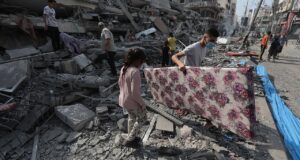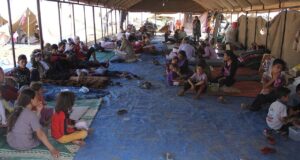By Julie Lenarz – Executive Director.
2nd September 2013, Human Rights and Conflict Resolution, Issue 3, No. 11.
The United Nations announced that the total death toll in Syria has passed 60,000. In summer of 2011, roughly 1,000 people lost their lives per month. The figure has now risen to 5,000. It is said to be a conservative estimate with the actual numbers likely to be far higher.
Compared to other conflicts, the number of Syrian casualties now equals the total killed in the Arab-Israeli conflict since 1948 or, put differently, Assad butchered half the number of people over 22 months that Milosevic killed between 1992-1995 in the Balkans.
Yet there are no signs of any potential intervention by the international community, as long as Assad is not resorting to chemical and biological weapons — also known as the ‘red line’ policy of the Obama administration.
But shouldn’t tens of thousands of men, women and children not be a ‘red line’ in themselves? What is the acceptable human threshold of pain, given that we have said so many times: ‘never again!’
Some commentators suggest that we cannot do anything or that it is already too late to intervene effectively.
It is too late in the sense that the worst case scenario has already unfolded. What we see is that everything the Obama administration said would happen in the case of intervention, is actually taking place in the absence of leadership.
Islamists have hijacked the revolution and the opposition increasingly resorts to the tactics of terrorists.
Yet just because the situation on the ground is immensely bleak, and the post-Assad era likely to be chaotic, does not mean there is nothing we can do at all.
Damage control is still an option.
The Patriots along the Turkish/Syrian border could be utilised to establish a partial no-fly-zone without entering Syrian airspace. This is significant, as the Assad regime‘s preferred modus operandi is to kill from the air.
It would also allow us to establish humanitarian corridors to provide shelter. Right now, refugees are pouring into Jordan, Lebanon, Iraq and Turkey, at a rate of up to several thousand a day, and they have reached a breaking point of capacity.
The violence in Syria has also spilled into neighbouring countries. For instance, it manifests itself in the noteworthy increase of terrorist attacks in Iraq over the last few months. The crisis in Syria allowed Al Qaida to slip back into the country and with US troops gone, Iraq once more is at risk of descending into chaos.
It would also make sense to consider arming parts of the opposition. Such undertaking would not be without risk but what is happening right now is that while we refuse to engage with the secularists, Saudi Arabia and Qatar are arming the Islamist rebels with our weapons. The extremists grow stronger by the day. The people we should support, however, are side-lined.
The Syrian problem is not going away and the longer we wait, the uglier it will become. That is a lesson history has taught us many times.
We still have a choice. We always have one, even if it is a choice between the lesser of two evils.
Right now, Washington appears to be the major obstacle to intervention. No Western country has taken the full initiative but France, for instance, suggested the establishment of a no-fly-zone months ago.
Syria is one of the Obama administration’s greatest foreign policy miscalculations and will haunt the President throughout his second term.
As one Syrian woman put it: ‘We will not forget that you forgot about us.’
Julie Lenarz is contactable at:
Julie.Lenarz@hscentre.org
Please cite this article as:
Lenarz, J, (2013) ‘Syria: Death Toll Tops 60,000’. Human Security Centre, Human Rights and Conflict Resolution, Issue 3, No. 11.
 Human Security Centre Human Rights and International Security Research
Human Security Centre Human Rights and International Security Research



